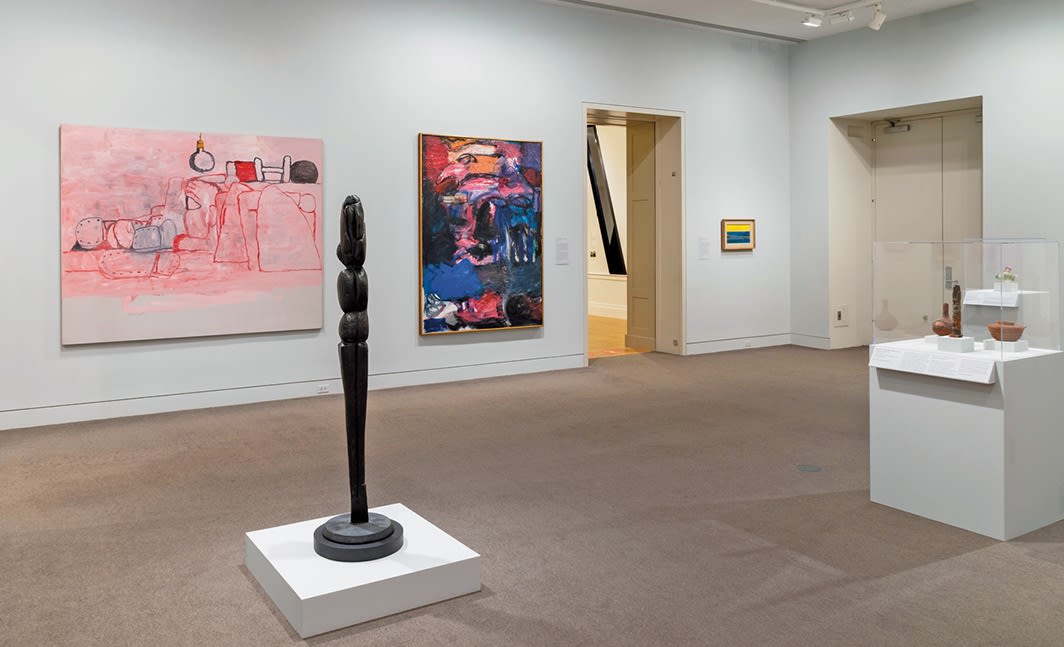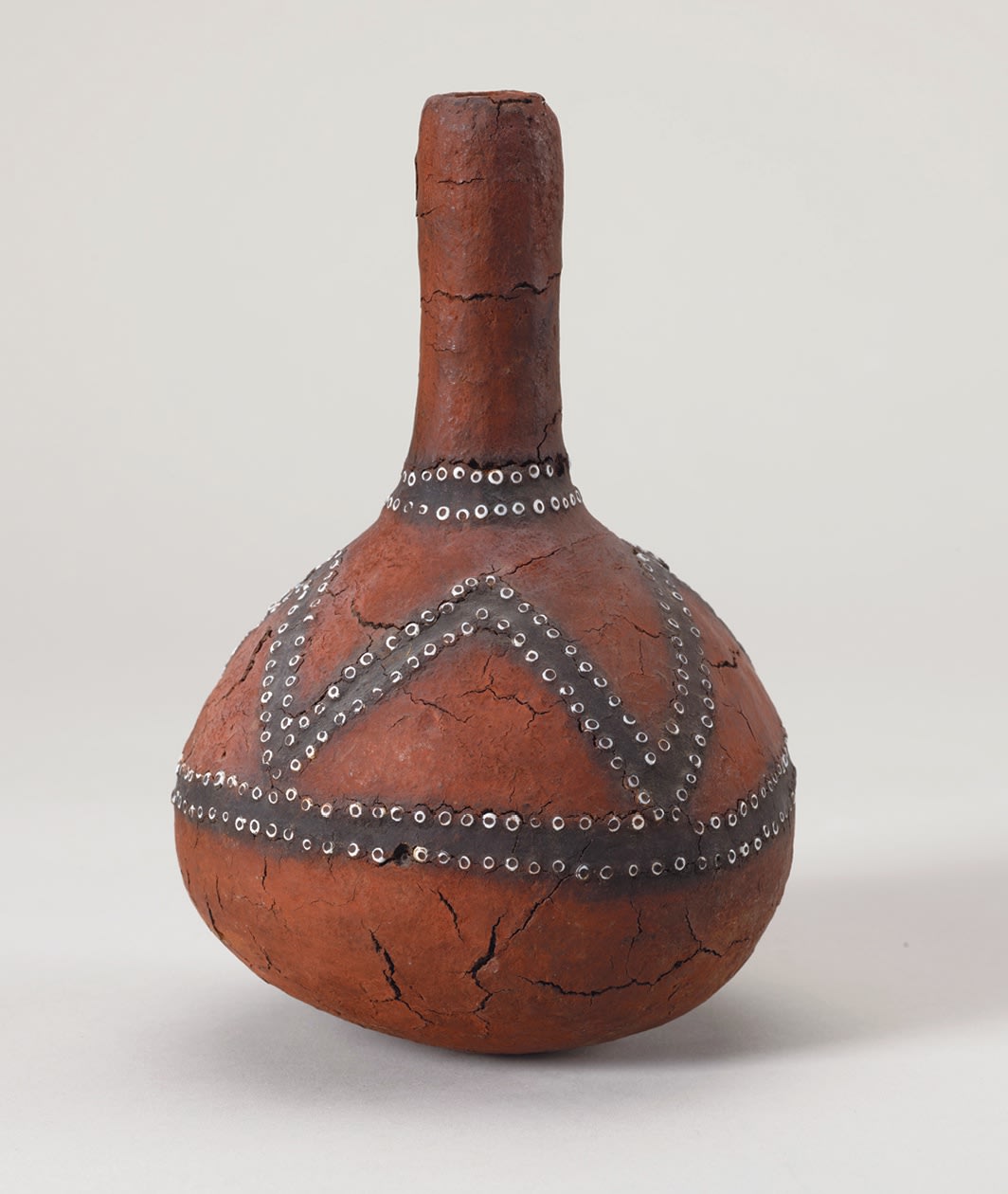
Ciarán Finlayson on “Guarding the Art”
IN 1968, thirteen Black security officers and gallery attendants at the Los Angeles County Museum of Art hosted a Black Culture Festival on museum grounds. As a successful piece of community outreach, the event, which coincided with the exhibition “The Sculpture of Black Africa,” was celebrated, earning lead organizer Sergeant William Knight and head of security Sidney Slade commendations from the Los Angeles County board of supervisors. In art historian Bridget R. Cooks’s telling, this cultural intervention led directly to the museum’s hiring David Driskell to guest-curate the major exhibition “Two Centuries of Black American Art” eight years later.
The Baltimore Museum of Art’s current show “Guarding the Art” is indebted to the LACMA guards’ pioneering initiative but operates rather differently. In this permanent-collection show guest-curated by seventeen gallery attendants, the security staff function not as the museum’s direct line into communities outside of it but as its blue-collar workers—extensions of the museum who are variously engaged with and alienated from its daily operations and social function. At the suggestion of Amy Elias, a museum trustee, the curatorial team surveyed forty-five members of the security team to gauge interest in the exhibition, which is positioned as an opportunity for professional development for employees. The show was supervised by Lowery Stokes Sims, former director of the Studio Museum in Harlem; spearheaded by BMA chief curator Asma Naeem; and curated in consultation with the museum’s preparators and librarians. Together, this group selected twenty-five works for display, wrote highly personal wall labels, and assembled a small catalogue. (A few selections are on view only in the publication, in some cases because the works were unavailable and in others out of consideration for gallery attendants, whose jobs would have been made more difficult by their inclusion.)

View of Guarding the Art, 2022, Baltimore Museum of Art. Photo: Mitro Hood.
This placement of curatorial power in the hands of the museum’s nonprofessional class is one piece—perhaps the last—of the progressive reform pursued by the BMA’s outgoing director, Christopher Bedford (another notable effort being the controversial, thwarted deaccessioning of works by Brice Marden, Clyfford Still, and Andy Warhol, intended to enable the acquisition of more work by women and artists of color). The show doesn’t purport to make any large claims about the collection or even attempt to tell a story connecting the selections. Instead, it offers an engaging portrait of the guards’ interests and tastes. Mickalene Thomas’s cinematically large Resist #2, 2021, is a panel with rounded edges showing collaged scenes from the civil rights movement and the wave of demonstrations in Baltimore following the 2015 police murder of Freddie Gray. Distorted blue stars made of glitter add depth to the painting’s surface and give it the disorienting appearance of a waving flag. It was selected by Traci Archable-Frederick, who was in the army and worked for the Department of Homeland Security before joining the museum in 2006, and who chose it because it speaks to the state of things two years after the George Floyd mobilizations. Jeremy Alden’s 50 Dozen, 2005/2008, a fragile chair made of Ticonderoga pencils and adhesive, was chosen by Ben Bjork, who studied philosophy at the University of Baltimore, because visitors find it relatable and guards find it impish—a tease for their tired legs.

Water bottle, Mono culture, Solomon Islands, early 20th century,coconut, bamboo, Parinarium nut paste, glass beads, pigment, 16 1⁄8 × 8 1⁄8 × 5 1⁄2".
In a gesture reminiscent of Fred Wilson’s “Mining the Museum,” 1992–93, at the Maryland Historical Society in Baltimore, Ricardo Castro, a career security worker and music producer who attended the Community College of Baltimore County, left an empty plinth in a vitrine of defiantly contemporary pre-Columbian earthenware figures, highlighting a gap in the museum’s collection of Puerto Rican art and inviting Boricua visitors to imagine their own work on display. The labor of institutional critique has blessedly devolved from the credentialed full-time artist to the worker.
Rob Kempton, a poet with an MA in museum studies, and Jess Bither, a Maryland Institute College of Art adjunct with an MA in critical studies, each selected a massive, impassioned Grace Hartigan canvas: the self-portrait Pallas Athena—Fire, 1961, and the Long Island living-room scene Interior, ‘The Creeks,’ 1957, respectively. Chris Koo, who studied animation for a year at the School of Visual Arts in New York, chose Philip Guston’s The Oracle, 1974, in which two comic-book Klansmen approach the artist from behind with a bullwhip. In front of them is a pile of shoes with thick soles facing outward, Guston’s deadpan icon of the Holocaust.Oracle, dreamy and ominous, is hung near the decisive and vital Athena, so that the smudges of pink and black in each seem to be in conversation. They’re installed opposite a 1957 Rothko multiform, the label for which reads simply, THOUGHTS?, and not far from Thomas’s Resist #2, forming a charged circuit of worldly meaning. As Archable-Frederick says in a curators’ roundtable in the catalogue, “Rothko’s Black over Reds could be meditative, or it could be read as bloodshed on Black people.”
Several smaller, lighter-hearted works in the same room offset the gravity of this grouping. Bjork selected an 1882 teapot depicting a wing-collared dandy whose limp wrists serve as the spout because it’s funny. That said, the way the selectors contextualize some of these objects belies their unassuming or decorative appearance. For example, an early-twentieth-century water bottle from the Solomon Islands, made of coconut and bamboo and selected by former nurse assistant and grandmother of nine Joan Smith, is characterized in the label in terms of human self-preservation, its durability contrasted with the epidemic of plastic waste.
The diversity of the curators’ approaches, sensibilities, and interests exemplifies the heterogeneity of the working class—by race, gender, and nationality, of course, but also by degree attainment and level of professionalization—and of the labor force within what theorist John Roberts calls the “second economy” of contemporary art. One guard who has been at the museum for eight years studied with Hartigan in the 1980s; a three-year member of the security team just completed a thesis on Hegel’s notion of alienation; and still another, Kellen Johnson, who has been with the museum since 2013, previously worked security in the Marlborough apartments, where the museum’s largest donors, sisters Claribel and Etta Cone, once resided with their Matisse collection. (In 1973, the palatial suites were subdivided into low-income subsidized units, where Johnson’s grandmother subsequently lived.) Other cocurators are skaters, writers, National Guardsmen, and, now, trade unionists.

View of Guarding the Art, 2022, Baltimore Museum of Art. Photo: Mitro Hood.
Workers from across departments, including nine guards involved in this show, announced a union drive last September and have leveraged the media blitz around this worthy exhibition to advance the campaign, itself two years in the making. (Indicative of the need for such organizing: Approximately one third of the exhibition’s curators no longer work for the museum.) Demonstrating outside the press preview, pro-union employees held signs bearing messages including GUARDING THE GUARDS, turning a thoughtful and well-executed curatorial exercise into a bread-and-butter issue. Taking the exhibition at its word, these employees have made the formation of a wall-to-wall union dovetail with the goals of the progressive administrators, to “change the long-standing cultural canon of privilege at our museum” (as the union’s mission statement puts it). At the time of this writing, it had been more than two months since the agreement that would allow the city of Baltimore to hold the union election landed on the director’s desk, and Bedford, who in June will begin a new position as director of the San Francisco Museum of Modern Art, had not signed it. (The museum disputes that the city can hold an adequate election, preferring oversight by the National Labor Relations Board instead.)
Though it occasionally risks prioritizing sociological insight and individual psychology, “Guarding the Art” reminds us, as Adorno did in the late 1960s, that “art perceived strictly aesthetically is art aesthetically misperceived.” In showing the correspondences among the social situation of the guards, the imperatives of the job, and the curatorial reasoning on display, the exhibition sheds light on art’s double character as autonomous and fait social, engaging openly with the imbricated realms of private affect and commodity status that continue to define not just the work of art but all criticism, curation, and spectator
-ARTFORUM Summer 2022 Print Issue

